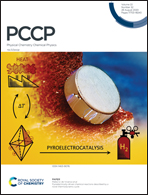New insight into the interaction between divacancy and H/He impurity in Ti3AlC2 using first-principles studies†
Abstract
First-principles calculations have been conducted to investigate the interaction between vacancy defects and H/He impurity in Ti3AlC2. The formation energies of monovacancy and divacancy have been calculated. It is found that Al monovacancy (VAl), Al divacancy (2VAl–Al), and the divacancy composed of Al and C atoms (2VAl–C) are most easily formed in all vacancies. In addition, the interactions between multiple vacancies are weak. The formation of vacancy is relatively independent and not affected by other vacancies. The configurations and energies of H–mV (m = 0, 1, 2) complexes have been studied to assess the energetically favorable sites for H atoms. Within pre-existing VAl or 2VAl–Al, the most favorable site for H atoms is the Itetr-2 site, but the H atom tends to occupy the Ioct-4 site within 2VAl–C. The formation energies of the secondary vacancy defect nearest to an Al vacancy or C vacancy are significantly influenced by H impurity content. H clusters trapped in a primary Al vacancy can promote the formation of vacancy and prefer to form platelet-like bubbles parallel to the Al plane, while H clusters trapped in a primary C vacancy have higher probability to form spherical ones. The 2VAl–Al and 2VAl–C divacancies exhibit stronger H trapping ability than monovacancy. The 2VAl–Al divacancy could capture up to seven H atoms, and 2VAl–C could capture six H atoms. Meanwhile, the He–2VAl–Al complex could only capture four H atoms to form H–He hybridized bubbles, and He impurities effectively suppress further aggregation of H atoms. The present results provide microstructural images of nH–mV and nH–He–mV complexes as well as the evolution progress of H bubbles in Ti3AlC2, which is especially helpful for us to understand the behavior of H/He in Ti3AlC2 under irradiation.



 Please wait while we load your content...
Please wait while we load your content...